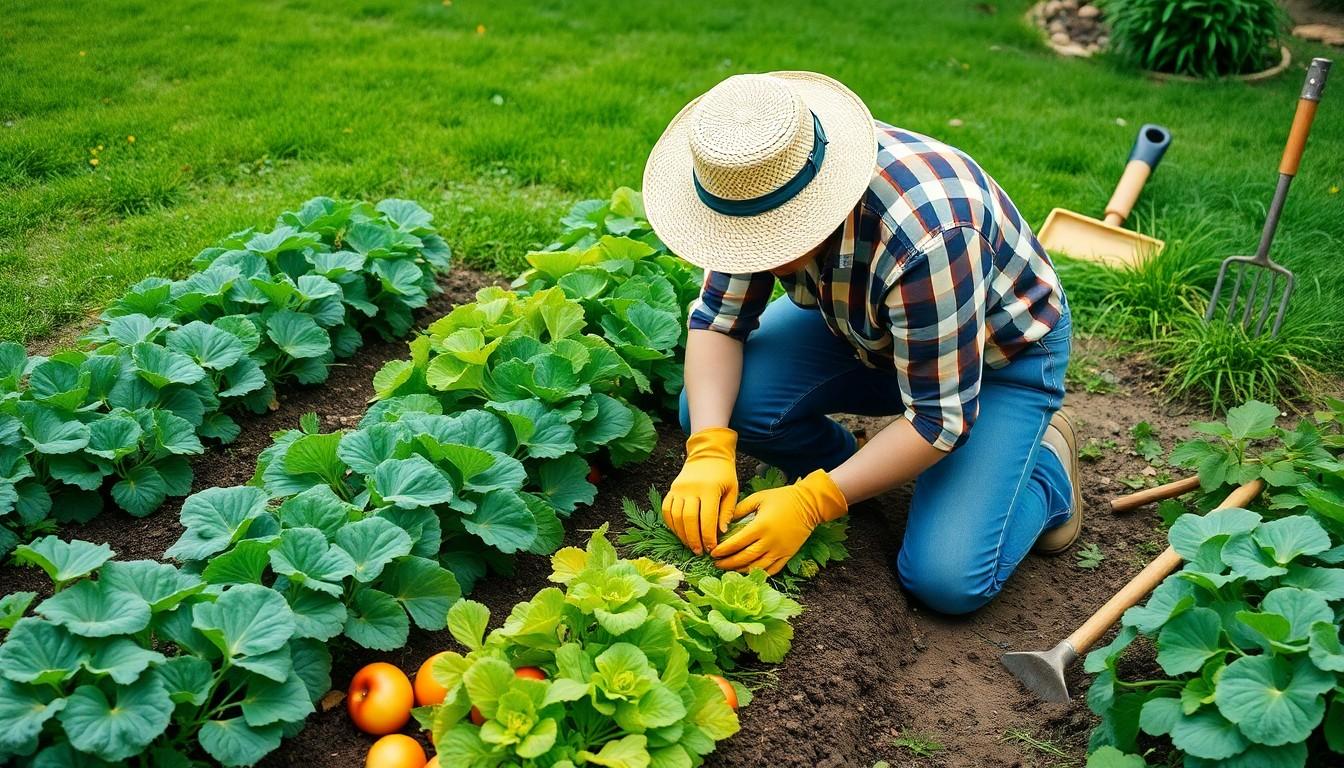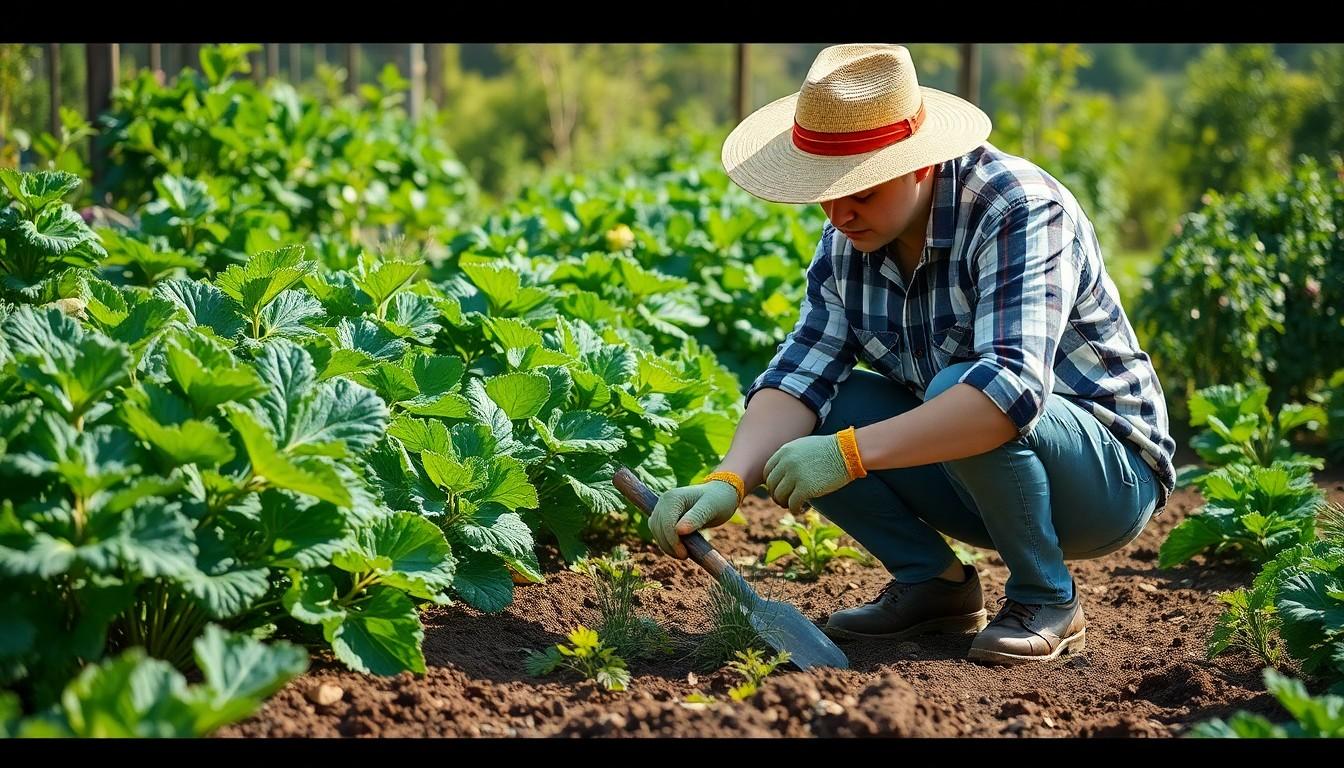Physical Address
304 North Cardinal St.
Dorchester Center, MA 02124

A vegetable garden should be a thriving oasis of fresh produce, not a jungle of unruly weeds staging a hostile takeover. If you’ve ever found yourself knee-deep in a green sea of unwanted intruders, you know the struggle is real. Those pesky weeds don’t just steal nutrients; they’re like that friend who shows up uninvited and eats all your snacks.
Weeds significantly affect garden health and productivity. Recognizing their types and the consequences of their growth helps gardeners effectively manage their vegetable gardens.
Annual weeds, like crabgrass and chickweed, germinate quickly and complete their life cycles within a year. Perennial weeds, such as dandelions and bindweed, survive multiple seasons and often invade gardens repeatedly. Biennial weeds take two years to mature, with examples including burdock and foxglove. Grass weeds also pose a threat, as they compete aggressively with vegetables for resources. Identifying these common types is crucial for effective management.
Weeds compete with vegetables for essential resources, including water, nutrients, and sunlight. High weed density can lead to reduced yields, stunted growth, and lower quality produce. Weeds harbor pests and diseases, contributing to overall garden decline. They also disrupt soil structure and prevent air circulation, harming root development. Acknowledging these effects enables gardeners to prioritize weed management and sustain healthy growth for their vegetables.

Effective weed removal begins with proper preparation. Gardeners can enhance their chances of success by taking specific steps before tackling the weeds.
Evaluating the garden’s weed situation involves observing the types and density of the weeds. Identifying areas with high weed concentration aids in deciding where to focus efforts first. Consider examining the entire garden plot to understand the variety of weeds, such as annual or perennial types. A thorough assessment helps prioritize actions, especially if invasive weeds dominate. Note any patches of weeds harboring pests, which could threaten vegetable health. Documenting the extent of the issue sets the stage for targeted weed removal strategies.
Acquiring the right tools simplifies the weed removal process. Essential items include a hoe for digging, garden gloves for protection, and a rake for clearing debris. Securing a spade or trowel allows for digging out rooted weeds. A mulch can hinder weed regrowth after removal. Additionally, consider having a bucket or cart handy for disposing of pulled weeds. Gathering these supplies ensures readiness, streamlining the removal and promoting efficiency in the garden.
Effective weed management techniques play a crucial role in maintaining a healthy vegetable garden.
Manual removal provides an immediate solution for tackling weeds. Pulling weeds by hand can eliminate individual plants, especially when done after a rainfall, as the soil becomes loose. Gardeners should grasp the weeds close to the base and remove the entire root to prevent regrowth. Employing tools like hoes can aid in loosening soil around deep-rooted weeds. Consistent monitoring of the garden helps identify and manage new weed growth quickly. Regularly checking the garden area for small weeds prevents competition with vegetable plants.
Mulching acts as a preventive barrier against weed growth. Applying a thick layer of organic mulch around vegetable plants retains moisture while blocking sunlight from reaching weed seeds. Effective materials include straw, wood chips, or grass clippings. This method not only suppresses weeds but also enhances soil fertility as the mulch decomposes. Gardeners should reapply mulch periodically to maintain optimal thickness and effectiveness. Observing the garden helps identify areas requiring more mulching to ensure thorough coverage.
Organic herbicides offer a chemical-free option for weed management. These products are often made from natural ingredients that disrupt weed growth without harming vegetable plants. Applying them during warm, sunny conditions can enhance their effectiveness. Organic herbicides typically target the foliage of weeds, causing them to wilt and die. Following manufacturer instructions ensures correct application rates for optimal results. Combining this method with manual removal or mulching creates a comprehensive weed management strategy. Regular application can keep weed populations under control while promoting a healthy garden environment.
A weed-free vegetable garden requires consistent care and attention. By implementing effective maintenance strategies, gardeners promote healthy plant growth while minimizing the chances of weed infestation.
Set a regular schedule for garden inspections to identify and address weed growth promptly. Frequent check-ups allow for early detection of new weeds. Hand-pulling is an effective method when dealt with small patches, especially after rain when the soil is soft. Keep pathways clear to reduce weed spread. Introducing companion planting can deter weeds while promoting beneficial relationships among plants. Finally, maintaining good plant spacing ensures that crops compete effectively against weeds for nutrients and sunlight.
Prioritizing soil health is vital for a thriving vegetable garden. Enriching soil with organic matter, like compost, improves nutrient availability. Regular testing of soil pH helps tailor amendments according to specific plant needs. Crop rotation strategies can disrupt weed life cycles, leading to reduced competition. Implementing cover crops during the off-season protects soil structure while suppressing weeds. Mulching also supports soil moisture retention and temperature regulation, further contributing to overall garden health.
A weed-free vegetable garden is essential for maximizing productivity and ensuring healthy crops. By implementing effective weed management strategies like manual removal mulching and the use of organic herbicides gardeners can reclaim their spaces. Regular maintenance and proactive measures are key to preventing weed resurgence.
With a commitment to consistent care and attention gardeners can create an environment that fosters growth and minimizes competition for resources. Embracing these practices not only enhances the garden’s health but also leads to bountiful harvests. A little effort goes a long way in cultivating a thriving vegetable garden.